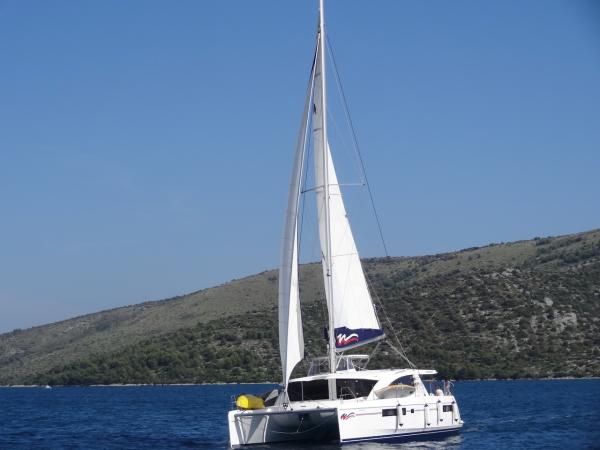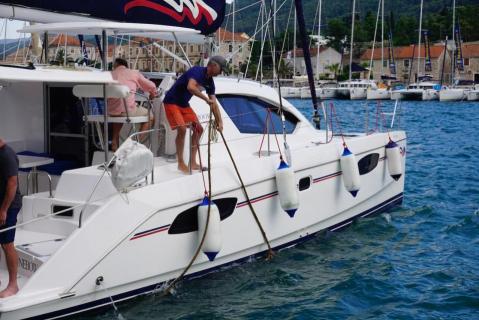No Apparent Cause: Engine Repair Underway
“From the CCA School of Hard Rocks
...lessons learned in pursuit of the Art of Seamanship”
By Chuck Hawley, SAF Station
In 2019, Susan and I invited three other couples to join us on a Croatian sailboat charter, where we’d reserved a nearly new Moorings 4600s in Marina Agana, near Split, Croatia. The three couples were our closest friends, two of whom had substantial sailing experience while the third couple was positive and eager to learn.

Around the fifth day, we were powering along the north coast of Hvar Island when a loud buzzer sounded, indicating that our port engine was having an issue. We shut it down, and continued under our starboard engine alone. I pulled up the engine hatch, which allows complete overhead access to the engine, plus the ability to climb down for almost 360 degree access. There was a faint sweet odor which I could not identify, and the engine seemed pretty hot, but nothing looked amiss. The oil level was fine, the raw water strainer was full and didn’t have any debris in it, the hoses all looked good, and it just wasn’t obvious what the problem could be.
There did seem to be some sort of moisture on the interior surfaces of the engine enclosure, but those surfaces led down to a gel-coat covered bilge pan, intended to keep any engine drips from going beyond the engine and messing up the rest of the bilge.
Then I noticed the reservoir for the engine’s closed-loop cooling system. Since the combination of a thermostat and a heat exchanger keeps most marine inboards at very stable temperatures, it didn’t occur to me that we could be low on coolant. After I carefully removed the pressure cap on the reservoir, I couldn’t see any coolant in the tank. But how did the coolant escape, and where did it go?
As I mentioned, access to the engine(s) was from the top, and it was natural to put your foot on the top of the engine. A hose that contained coolant was on the top of the engine, and as I grabbed the hose to check its security, a crack in the wall of the hose opened up right next to a barbed brass plumbing fitting. Apparently, repeated footsteps from well-meaning mechanics on top of the engine and its hose fitting had cut the hose enough to let the coolant spray out and coat the interior of the engine compartment. That was the sweet smell that I had noticed. I unscrewed the hose clamp, cut the hose with a sharp knife, and reinstalled it.

But where had the gallon or so of coolant ended up? Additional inspection under the engine solved that problem. In addition to having a fiberglass pan to catch drips, there was also a small automatic bilge pump which had dutifully pumped all of the coolant overboard, leaving just a hint of red fluid surrounding it.
The Moorings had thoughtfully included a couple of quarts of engine oil, some extra briquettes for the grill, and thankfully, a gallon of coolant. After topping off the tank, the engine started immediately and never gave us a moment’s trouble.
Lessons learned or reinforced:
1. Heed your alarms.
2. Have a systematic process for identifying the cause of engine alarms. While I didn’t find a checklist of issues that would cause the engine alarm to sound, I think they would be pretty much the same for any inboard (and most outboard) engines.
a. Cooling water flow
b. Lubricating oil
c. An issue with a belt
d. “Fresh” water coolant flow
e. Clogged fuel filter?
3. The loss of an engine on a two-engine boat could impact your choices for the rest of the trip. In Croatia, virtually all mooring is done using lazy lines, and requires reasonably precise maneuvering in reverse. Many charterers had some challenges mooring with all systems running correctly; there is no way that we would have attempted this with a beamy cat with only one engine.
4. Bring spares. Having a gallon of coolant onboard was a great benefit. Sure, we could have used water, but that would have caused some mechanic down the line to drain the cooling loop so that they could be sure of the proper coolant mixture.
5. Have documentation. One thing I’ve noticed on relatively new charter boats is that most have a binder of information from the builder that’s very comprehensive. If you have a problem, and you can read semi-technical literature, you can generally solve (or at least diagnose) problems.





